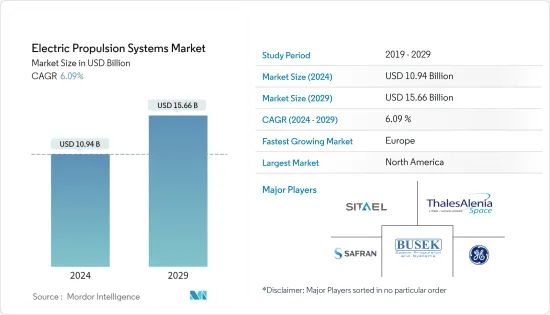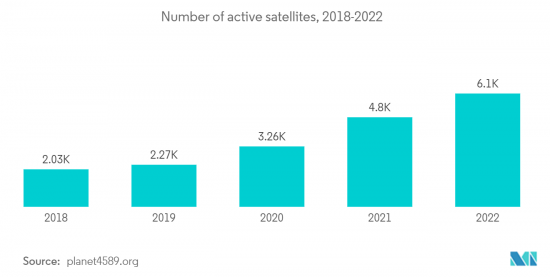PUBLISHER: Mordor Intelligence | PRODUCT CODE: 1405729

PUBLISHER: Mordor Intelligence | PRODUCT CODE: 1405729
Electric Propulsion Systems - Market Share Analysis, Industry Trends & Statistics, Growth Forecasts 2024 - 2029

The Electric Propulsion Systems Market size is estimated at USD 10.94 billion in 2024, and is expected to reach USD 15.66 billion by 2029, growing at a CAGR of 6.09% during the forecast period (2024-2029).
Space-based activities have flourished during the last decade, as evident from the number of satellites launched for both commercial and defense applications, ranging from telecommunication and earth observation to experimental scientific research. The absence of a combustion-supporting atmosphere in space has resulted in the increased adoption of electric propulsion technologies for maneuvering satellites in orbit.
Corporates and investors appear very keen to integrate electrical propulsion systems and capitalize on the shift towards a sustainable aviation market, given the spike in the related development activities in the aviation sector. All-electric and hybrid-electric drive systems allow aircraft to fly with power from renewable resources or fuel cells instead of only fossil fuels and make new aircraft designs possible. Besides, the emergence of global green emission initiatives has encouraged the adoption of eco-friendly propulsion technologies, such as electric propulsion.
Electric Propulsion Systems Market Trends
Space Segment Envisioned to Experience Highest Growth During the Forecast Period
The adoption and diffusion of new technologies, such as satellites, can help disseminate information over broad areas, enable instantaneous telecommunications, and generate and transmit high-resolution images of certain points of interest located around the world simultaneously. The advent of miniaturized electronics and the increasing use of smart manufacturing materials have resulted in the development of small satellites with shorter development cycles and lower deployment costs. The physical limitations of such satellites encourage the development and integration of powerful yet compatible electric propulsion systems to effectively perform orbital correction maneuvers. Several contracts are being awarded for the ongoing space missions. Strategic collaborations are underway to capitalize on joint capabilities to address an evolving market opportunity. For instance, in June 2022, Astra, a US-based space vehicle company, launched Astra Spacecraft Engine with a Krypton/Xenon propulsion system. The Astra Spacecraft Engine (ASE) is an electric propulsion system for constellations using a Hall-effect thruster propulsion system that has been flight-tested. Such developments are anticipated to drive the business prospects of the players in the market during the forecast period.

Europe to Experience Fastest Growth During the Forecast Period
According to the European Commission, airplane emissions currently account for about 3% of total EU greenhouse gas emissions and about 4% of world greenhouse gas emissions. The European Commission envisions attaining an ambitious goal of reducing greenhouse emissions to 40% below their 1990 levels by 2030 and to 80% of 1990 emissions by 2050. Since electrification is a viable solution for reducing greenhouse emissions, the region has emerged as a hotbed for the development of electric aircraft, electric automotive, and marine vessels and their related technologies. Significant research works in the field of electric aviation are carried out in Europe, as the region is home to several leading electric aircraft manufacturers. Until 2010, aircraft manufacturers were focused on transforming existing aircraft models by substituting IC engines with electric engines. In recent years, developments in electric propulsion have been driven by manufacturers' efforts in the realm of urban mobility. In Europe, Maritime transport plays and will likely continue to play an essential role in global and European trade and economy. In recent years, the maritime sector has taken significant measures to alleviate its environmental impacts. Ahead of a projected increase in global shipping volumes, a new report reveals for the first time the full extent of the impact of the EU maritime transport sector on the environment and identifies challenges to achieving sustainability. Similar developments are envisioned to enhance the demand for electric propulsion systems across all platforms, thereby driving the growth prospects of the market in focus during the forecast period.
Electric Propulsion Systems Industry Overview
The electric propulsion systems market is fragmented in nature. SITAEL SpA., Busek Co. Inc., General Electric Company, Thales Alenia Space, and Safran SA are some of the prominent market players. These companies are mainly into designing, manufacturing, and integrating complete electric propulsion systems for all application platforms. The market studied is highly competitive and is still evolving. Hence, to gain a competitive advantage and effectively conduct extensive R&D to develop sophisticated systems based on the MEA architecture, long-term collaborations are preferred in the whole supply chain. This poses a threat to new market entrants for participating in commercial and military aircraft programs. In the land sector for automobiles, Volkswagen, Toyota, and Volvo were estimated to be the largest players. In contrast, Chinese players are evaluated to account for a larger market share in the forecast period.
Additional Benefits:
- The market estimate (ME) sheet in Excel format
- 3 months of analyst support
TABLE OF CONTENTS
1 INTRODUCTION
- 1.1 Study Assumptions
- 1.2 Scope of the Study
2 RESEARCH METHODOLOGY
3 EXECUTIVE SUMMARY
4 MARKET DYNAMICS
- 4.1 Market Overview
- 4.2 Market Drivers
- 4.3 Market Restraints
- 4.4 Porter's Five Forces Analysis
- 4.4.1 Bargaining Power of Suppliers
- 4.4.2 Bargaining Power of Buyers/Consumers
- 4.4.3 Threat of New Entrants
- 4.4.4 Threat of Substitute Products
- 4.4.5 Intensity of Competitive Rivalry
5 MARKET SEGMENTATION
- 5.1 By Type
- 5.1.1 Hybrid
- 5.1.2 Full-electric
- 5.2 By Application
- 5.2.1 Airborne
- 5.2.2 Terrestrial
- 5.2.3 Marine
- 5.2.4 Space
- 5.3 Geography
- 5.3.1 North America
- 5.3.1.1 United States
- 5.3.1.2 Canada
- 5.3.2 Europe
- 5.3.2.1 United Kingdom
- 5.3.2.2 France
- 5.3.2.3 Germany
- 5.3.2.4 Italy
- 5.3.2.5 Rest of Europe
- 5.3.3 Asia-Pacific
- 5.3.3.1 China
- 5.3.3.2 India
- 5.3.3.3 South Korea
- 5.3.3.4 Japan
- 5.3.3.5 Rest of Asia-Pacific
- 5.3.4 Latin America
- 5.3.4.1 Brazil
- 5.3.4.2 Mexico
- 5.3.4.3 Rest of Latin America
- 5.3.5 Middle East and Africa
- 5.3.5.1 Saudi Arabia
- 5.3.5.2 United Arab Emirates
- 5.3.5.3 Saudi Arabia
- 5.3.5.4 Rest of Middle East and Africa
- 5.3.1 North America
6 COMPETITIVE LANDSCAPE
- 6.1 Vendor Market Share
- 6.2 Company Profiles
- 6.2.1 SITAEL SpA
- 6.2.2 Daihatsu Diesel Mfg. Co. Ltd.
- 6.2.3 Accion Systems Inc.
- 6.2.4 Busek Co. Inc.
- 6.2.5 Orbital ATK (Northrop Grumman Corporation)
- 6.2.6 Aerojet Rocketdyne Holdings, Inc.
- 6.2.7 General Electric Company
- 6.2.8 Safran SA
- 6.2.9 Airbus SE
- 6.2.10 The Boeing Company
- 6.2.11 Thales Alenia Space
- 6.2.12 Efficient Drivetrains Inc. (Cummins Inc.)
- 6.2.13 Collins Aerospace (RTX Corporation)
7 MARKET OPPORTUNITIES AND FUTURE TRENDS




